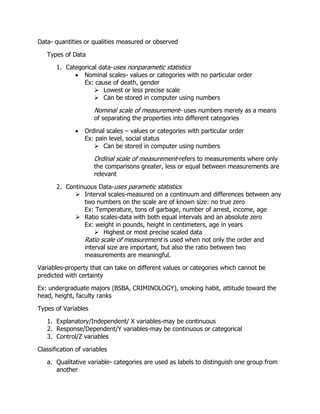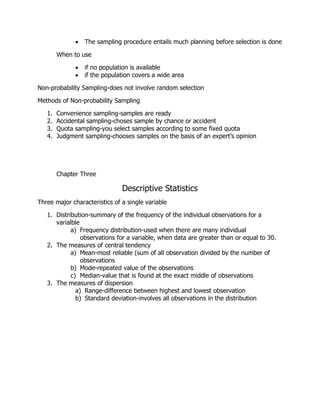Statistics
- 2. Chapter One Introduction Meaning Statistic (singular) - is a science that deals with the principles and procedures for the collection, organization, summarization, presentation and analysis of numerical data. Statistics (plural)-set of data or mass of observation Fields of statistics Mathematical statistics- development and exposition of theories Applied statistics- application of statistical methods to solve real problems Branches of Statistics Descriptive statistics- methods of summarizing and presenting data (collection, extraction, summarization, presentation, measures of central tendency, measures of location and measures of variability) Inferential statistics-the process of drawing and making decision on the population based on evidence obtained from a sample (estimation and hypothesis testing) Classification of Statistics Parametic statistics- is an approach which assumes a random sample from a normal distribution and involves testing of hypothesis about the population parameter Appropriate for interval and ratio data Requires large sample size to appeal normality Nonparametic statistics/distribution-free method-is an approach for estimating and hypothesis testing when no underlying data is assumed Can be used for nominal, ordinal scaled data Can be used for interval and ratio scaled data where the distribution of the random variable of interest is unspecified Good when there is not enough sample size to assess the form of the distribution
- 3. Data- quantities or qualities measured or observed Types of Data 1. Categorical data-uses nonparametic statistics Nominal scales- values or categories with no particular order Ex: cause of death, gender Lowest or less precise scale Can be stored in computer using numbers Nominal scale of measurement- uses numbers merely as a means of separating the properties into different categories Ordinal scales – values or categories with particular order Ex: pain level, social status Can be stored in computer using numbers Ordinal scale of measurement-refers to measurements where only the comparisons greater, less or equal between measurements are relevant 2. Continuous Data-uses parametic statistics Interval scales-measured on a continuum and differences between any two numbers on the scale are of known size: no true zero Ex: Temperature, tons of garbage, number of arrest, income, age Ratio scales-data with both equal intervals and an absolute zero Ex: weight in pounds, height in centimeters, age in years Highest or most precise scaled data Ratio scale of measurement is used when not only the order and interval size are important, but also the ratio between two measurements are meaningful. Variables-property that can take on different values or categories which cannot be predicted with certainty Ex: undergraduate majors (BSBA, CRIMINOLOGY), smoking habit, attitude toward the head, height, faculty ranks Types of Variables 1. Explanatory/Independent/ X variables-may be continuous 2. Response/Dependent/Y variables-may be continuous or categorical 3. Control/Z variables Classification of variables a. Qualitative variable- categories are used as labels to distinguish one group from another
- 4. Ex: cause of death, nationality, race, gender, severity of pain b. Quantitative variable-whose categories can be measured and ordered according to quantity; Ex: number of children in a family, age Quantitative variable classification: i. Discrete variables-values that is either finite or countably infinite There are gaps between its possible values Ex: number of missing teeth and number of household members ii. Continuous variables- has a set of possible values including all values in an interval of the real line Ex: Body Mass Index, height There is no gaps between possible values Sources of Data a) Primary source b) Secondary source Presentation of Data a) Textual presentation-uses statements b) Tabular presentation-uses statistical table c) Graphical presentation-uses graph I. Bar graph II. Circle graph III. Line graph
- 5. Chapter Two Sampling Techniques Population [N]-totality of the individuals Target population-entire set of individuals which we require info from Sampled population-finite set of individuals from which sample is drawn Coverage error-when the sampled population and the target population are not identical Sample-representative portion of the population understudy Principle of Randomization “Four basic reasons for the use of samples” 1. It allows us to obtain information with greater speed 2. It allows us to obtain information with reduced cost 3. It allows us to obtain information over a greater scope 4. It allows us to obtain information with greater accuracy Probability sampling and Non-probability Sampling Probability sampling-uses random selection Methods of Probability Sampling 1. Simple random sampling-choosing a sample from a set Techniques in drawing SRS a) Table of Random Numbers b) Lottery of fishbowl technique May be done in two ways a) With replacement b) Without replacement Advantages Simple and is more easily understood that other sampling designs Disadvantages List of all the members in the population is needed. Assigning numbers to each member of the sampled population is frequently impractical. It may be difficult to collect the sample data with SRS if the samples are spread inconveniently throughout the population.
- 6. It is often less precise than other sampling plans because it disregards any information already known about the population. When to use When the population is homogeneous with respect to the characteristics understudy. 2. Systematic random sampling-selection of the desired sample in a list by arranging them systematically Formula: 𝑘 = N n Where k=sampling interval N=population size n=sample size Advantages: Easier to apply and less likely to make mistakes. It is possible to select a sample in the field without a sampling frame. It could give more precise estimate than SRS when there is order in the samples Disadvantages: If periodic regularities are found in the lists, a systematic sample may consist only of similar types If the population is not in random order, one cannot validly estimate the variance of the mean from a single systematic sample Could be less precise than SRS When to use: If the ordering of the population is essentially random When stratification with numerous data is used 3. Stratified random sampling- population [N] is divided into a number Advantages: Gain in the precision of the estimates of characteristics of the population It allows for more comprehensive data analysis since information is provided for each stratum Accommodate administrative convenience, fieldwork is organized by strata, which usually result in saving in cost
- 7. Accommodate different sampling plans in different strata Disadvantages: Sampling frame is necessary for every stratum Prior information about the population and its subpopulations is necessary for stratification purposes When to use: Population is known to be heterogeneous or the population can be subdivided into mutually exclusive and exhaustive groups 4. Cluster sampling- used when the population is very large and widely spread out over a wide range of geographical area Advantages: Sampling frame for the entire population is not necessary, only a frame of clusters, i.e., a list of clusters in the population Reduced listing and transportation costs The procedure saves time, effort and money Disadvantages: Entail more statistical analysis Estimation procedures are difficult, especially when the clusters are of unequal size When to use Sampling frame is not available and the cost of constructing such a frame is very high For economic consideration, i.e., when the time, effort and cost involved in obtaining information on the population units increase as the distances separating these units increase 5. Multistage sampling- the selection of sample is done in two or more stages Advantages: Like cluster sampling, transportation and listing cost are reduced Disadvantages: The procedures are difficult, especially when the first-stage units are not of the same size
- 8. The sampling procedure entails much planning before selection is done When to use if no population is available if the population covers a wide area Non-probability Sampling-does not involve random selection Methods of Non-probability Sampling 1. Convenience sampling-samples are ready 2. Accidental sampling-choses sample by chance or accident 3. Quota sampling-you select samples according to some fixed quota 4. Judgment sampling-chooses samples on the basis of an expert’s opinion Chapter Three Descriptive Statistics Three major characteristics of a single variable 1. Distribution-summary of the frequency of the individual observations for a varialble a) Frequency distribution-used when there are many individual observations for a variable, when data are greater than or equal to 30. 2. The measures of central tendency a) Mean-most reliable (sum of all observation divided by the number of observations b) Mode-repeated value of the observations c) Median-value that is found at the exact middle of observations 3. The measures of dispersion a) Range-difference between highest and lowest observation b) Standard deviation-involves all observations in the distribution





![Chapter Two
Sampling Techniques
Population [N]-totality of the individuals
Target population-entire set of individuals which we require info from
Sampled population-finite set of individuals from which sample is drawn
Coverage error-when the sampled population and the target population are not identical
Sample-representative portion of the population understudy
Principle of Randomization
“Four basic reasons for the use of samples”
1. It allows us to obtain information with greater speed
2. It allows us to obtain information with reduced cost
3. It allows us to obtain information over a greater scope
4. It allows us to obtain information with greater accuracy
Probability sampling and Non-probability Sampling
Probability sampling-uses random selection
Methods of Probability Sampling
1. Simple random sampling-choosing a sample from a set
Techniques in drawing SRS
a) Table of Random Numbers
b) Lottery of fishbowl technique
May be done in two ways
a) With replacement
b) Without replacement
Advantages
Simple and is more easily understood that other sampling designs
Disadvantages
List of all the members in the population is needed.
Assigning numbers to each member of the sampled population is
frequently impractical.
It may be difficult to collect the sample data with SRS if the samples
are spread inconveniently throughout the population.](https://izqule7twkl7vq3ljkxejyz-s-a2157.bj.tsgdht.cn/statistics-140804040259-phpapp01/85/Statistics-5-320.jpg)
![ It is often less precise than other sampling plans because it disregards
any information already known about the population.
When to use
When the population is homogeneous with respect to the
characteristics understudy.
2. Systematic random sampling-selection of the desired sample in a list by
arranging them systematically
Formula: 𝑘 =
N
n
Where k=sampling interval
N=population size
n=sample size
Advantages:
Easier to apply and less likely to make mistakes.
It is possible to select a sample in the field without a sampling frame.
It could give more precise estimate than SRS when there is order in
the samples
Disadvantages:
If periodic regularities are found in the lists, a systematic sample may
consist only of similar types
If the population is not in random order, one cannot validly estimate
the variance of the mean from a single systematic sample
Could be less precise than SRS
When to use:
If the ordering of the population is essentially random
When stratification with numerous data is used
3. Stratified random sampling- population [N] is divided into a number
Advantages:
Gain in the precision of the estimates of characteristics of the
population
It allows for more comprehensive data analysis since information is
provided for each stratum
Accommodate administrative convenience, fieldwork is organized by
strata, which usually result in saving in cost](https://izqule7twkl7vq3ljkxejyz-s-a2157.bj.tsgdht.cn/statistics-140804040259-phpapp01/85/Statistics-6-320.jpg)

